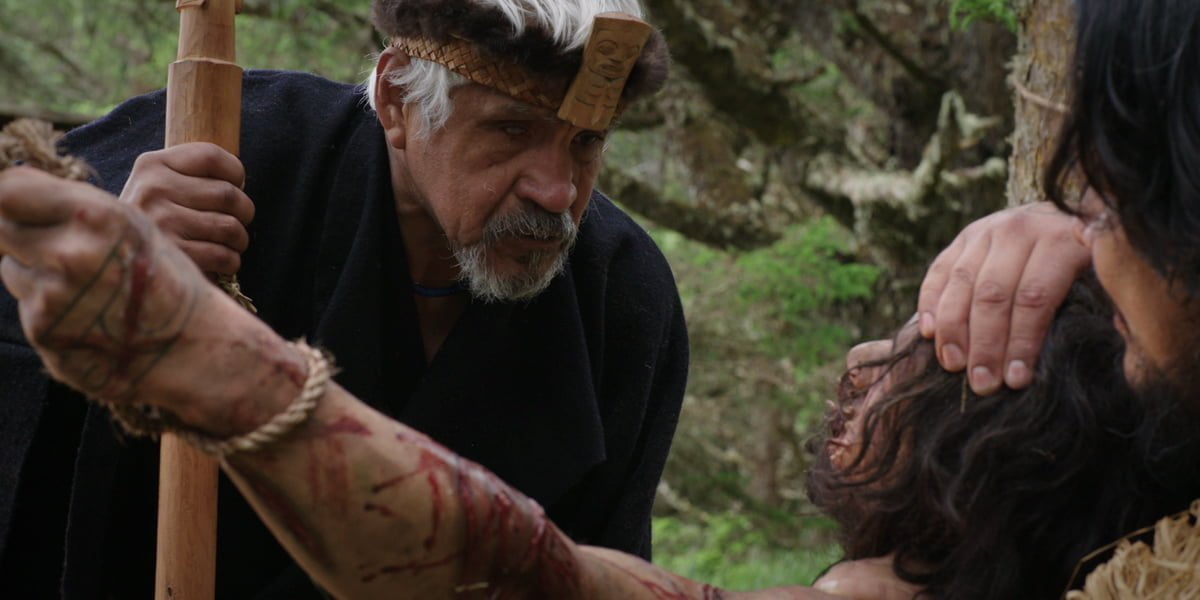A landmark achievement in the history of indigenous cinema, SGaawaay K’uuna – or Edge of the Knife in English – is a mesmerizing film crafted by true artists, performed largely by inexperienced actors, and told through a language that’s spoken fluently today only by roughly two dozen people. A directorial collaboration between filmmaker Helen Haig-Brown and indigenous visual artist Gwaai Edenshaw, Edge of the Knife is a film concerned with family tradition, mythmaking, and legend, but also a unique glimpse into the rich history of the Haida, who’ve been keepers of the own land in Northern British Columbia for over 14,000 years.
The story in Edge of the Knife isn’t nearly that old. It’s set in the 19th century amongst the members of a tribe that has made a lengthy, annual summertime pilgrimage to stockpile food and supplies for the harsh winter ahead. Two of the hunter-gatherers are Kwa (Willy Russ), a pragmatic family man, and his closest friend, Adiits’ii (Tyler York), a confident and jovial, but reckless young man. Confident that he can catch some prized black cod before they have to pack up camp for the season, Adiits’ii takes Kwa’s eager young son (Greg Brown) out on what’s essentially an unsanctioned fishing trip. Tragedy strikes, and the body of Kwa’s boy washes ashore, while Adiits’ii is stranded in the middle of the woods. Understandably grief stricken and blaming Adiits’ii for his loss, Kwa isn’t too keen on searching for his former ally, and the tribe is forced to migrate back home before colder weather begins to set in. In the woods, Adiits’ii starts going mad and becoming desperate for any means of survival. He has been possessed by the spirit of Gaagiixid, a savage monster. Adiits’ii survives the winter and finds his way back to the abandoned camp, but when the revenge minded Kwa and the rest of the tribe return to the following year, any trace of the young man they once knew is gone.
Stories built around familial grief and rifts borne from avoidable tragedies – even those tinged with supernatural horror elements – aren’t anything new, but Edge of the Knife is a film unlike any other. Although it’s captivating on its own merits as a simple story steeped in tradition, ritual, and superstition, Brown and Edenshaw’s film deserves an undeniable amount of credit for playing a role in the preservation of indigenous culture on screen. Shot on the island of Haida Gwaii, on picturesque, largely untainted native land, Edge of the Knife’s status as a landmark work of cinema should be obvious, and not just because the actors are speaking in dialects that might never be heard in a film ever again. It’s place in Canadian cinematic history goes well beyond that.

How many films about the indigenous experience – no matter how well intentioned – haven’t been skewed by the attitudes, prejudices, and assumptions made by colonizers? Distressingly few. Every film made by indigenous artists or story told within these communities helps to preserve marginalized cultures. What makes Edge of the Knife all the more special is its attention to detail. Brown and Edenshaw weave a storytelling rhythm that feels unique and bracing. Edge of the Knife is attuned to tradition and a way of life that no one has seen on screen before. It’s a film that presents itself confidently and without compromise; an honest, true-to-the-definition work of art.
Although a lot has been said about Edenshaw and Brown’s employment of Haida dialects, much of Edge of the Knife is told wordlessly and evocatively; most memorably of all Adiits’ii’s descent into madness, a sequence so wrenching in its beautiful brutality that it transcends language. Edenshaw and Brown enlist the help of cinematographer Jonathan Frantz, who brought a similar sense of style and edginess to indigenous filmmaker Zacharias Kunuk’s barren Inuit western Searchers a few years ago. Edge of the Knife contains countless, memorable close-up shots of any number of things worth showing in vivid detail: farming practices, tattoos, food preparation, calloused hands, skin abrasions. It’s an inviting, intimate technique to employ for a film that’s ostensibly a melodramatic thriller. The viewer is put into such close proximity to the cultural details that every wide shot included by Brown and Edenshaw carries with it ominous and foreboding tones. The moment the camera pulls back to show the expansive sky or seemingly endless forests, the viewer knows that something menacing is lurking somewhere close.
It’s those details that matter most and will resonate loudest with all viewers. The story and the performances aren’t the biggest attractions contained within Edge of the Knife, but how they’re being presented should give viewers pause for reflection. By colonial standards, Edge of the Knife is a resolutely original motion picture, but what it means to the culture it represents and preserves within its frames speaks volumes more.
SGaawaay K’uuna (Edge of the Knife) opens at TIFF Bell Lightbox in Toronto on Friday, April 5, 2019.
Check out the trailer for SGaawaay K’uuna (Edge of the Knife):
Join our list
Subscribe to our mailing list and get weekly updates on our latest contests, interviews, and reviews.

